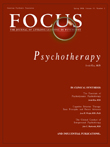The Essentials of Psychodynamic Psychotherapy
Abstract
Psychodynamic psychotherapy, in all its forms, is the psychotherapy most frequently provided by psychiatrists. Psychodynamic therapy is useful in long-term, short-term, supportive, crisis intervention, and group/family therapies, with patients of all ages. Patients hospitalized in psychiatric as well as medical-surgical services can also benefit from a clinician’s psychodynamic orientation. The effectiveness and efficacy of psychodynamic psychotherapy are supported by a growing literature. This article describes and discusses the clinically useful tenets of the psychodynamic view and the attractive explanatory power the approach offers regarding behavior, motivation, and adaptation. Central psychodynamic techniques, such as constructing useful interpretive interventions and ensuring a patient’s emotional and physical safety by establishing professional boundaries, are reviewed.



